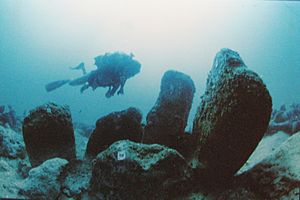Atlit Yam facts for kids
|
הכפר הנאוליתי בעתלית-ים
|
|

Submerged stone structure
|
|
| Location | Off the coast of Atlit, Israel |
|---|---|
| Region | Eastern Mediterranean Sea |
| Coordinates | 32°42′38.98″N 34°56′6.54″E / 32.7108278°N 34.9351500°E |
| Type | Settlement |
| Area | 40 dunams (9.9 acres) |
| History | |
| Founded | 6900 BCE |
| Abandoned | 6300 BCE |
| Periods | Pre-Pottery Neolithic B |
Atlit Yam is an amazing ancient village found underwater off the coast of Atlit, Israel. It's a very old place, carbon-dated to be between 8,900 and 8,300 years old. This means it existed during the Neolithic period, also known as the New Stone Age.
The site covers about 4.0 ha (10-acre) and has many interesting features. One of the most famous is a large stone circle that still stands today.
Contents
Discovering Atlit Yam's Past
Atlit Yam gives us the earliest proof of how people lived on the Levantine coast. They used a mix of farming, raising animals, and fishing to get their food. This way of life is called an agro-pastoral-marine subsistence system.
When Was Atlit Yam Built?
Scientists used carbon dating to figure out the age of Atlit Yam. They found it is between 8,900 and 8,300 years old. This time period is known as the final Pre-Pottery Neolithic B period.
Where is Atlit Yam Located?
Today, Atlit Yam is deep under the Mediterranean Sea. It lies about 8 to 12 meters (25 to 40 feet) below the water's surface. You can find it in the Bay of Atlit, near where the Oren river meets the sea. This area is along the Carmel coast.
Why is Atlit Yam Underwater?
The village of Atlit Yam was once on dry land. After the last Ice Age ended, sea levels slowly rose. This rise in sea levels, called eustatic rise, covered the village over time. Experts believe the coastline was about 1 kilometer (half a mile) west of where it is now.
Archaeologists found piles of fish ready for trade or storage at the site. This suggests the village was left very quickly. Some scientists think a huge tsunami might have hit the coast. An Italian study suggests a volcanic collapse of Mount Etna 8,500 years ago could have caused a 40-meter (10-story) tsunami. This tsunami would have reached Mediterranean cities in just a few hours. The sudden abandonment of Atlit Yam around the same time makes some scientists think this tsunami really happened.
Amazing Finds at Atlit Yam
Since the 1960s, many ancient settlements and shipwrecks have been found along the Carmel coast. This happened because of large-scale sand quarrying in the area. In 1984, a marine archaeologist named Ehud Galili found the remains of Atlit Yam while looking for shipwrecks.
Houses and Wells
Underwater digs have revealed the remains of rectangular houses. They also found places where people made fires, called hearth-places. A well was also discovered, which is now 10.5 m (34 ft) below sea level. This well was built with dry stones, was 1.5 m (4 ft 11 in) wide, and 5.5 m (18 ft) deep.
Inside the well, archaeologists found tools made of flint, ground stone, and bone. They also found animal bones. The top layer of bones suggests animals were thrown in after the well was no longer used. Other round structures at the site might also be old wells. Some experts believe the well water became salty, forcing the villagers to leave.
The Stone Circle
One of the most exciting discoveries is a stone semicircle. It has seven huge stones, each weighing about 600 kg (1,300 lb). These stones are called megaliths. They have special cup marks carved into them. The stones are arranged around a freshwater spring. This suggests they might have been used for a water ritual or ceremony.
Human Remains and Daily Life
Archaeologists found ten human skeletons buried in a bent position, called flexed burials. These were found both inside and near the houses. In 2008, the skeletons of a woman and child were found. They showed the earliest known cases of a disease called tuberculosis.
Many fish-hooks made of bone and piles of fish bones were also found. This shows how important fishing and seafood were to the people of Atlit Yam. Some of the male skeletons had ear damage, likely from diving in cold water to collect seafood.
Other finds include human-shaped stone statues, called anthropomorphic stone stelae. Tools like arrowheads, sickle-blades (for harvesting crops), and axes were also discovered.
Excavations and Discoveries
The University of Haifa started an excavation on October 1, 1987. Just a few days later, on October 4, 1987, they found a complete human skeleton. It was in excellent condition, lying 10 metres (33 ft) underwater in a bent position. Carbon dating of plants found with the burial showed the site was about 8,000 years old.
They also found well-preserved animal bones and plant remains. Most animal bones were from wild species. Plant remains included wild grape, poppy, and caraway seeds. The presence of granary weevils suggests that grain was stored there. Pollen analysis and marsh plants show that swamps were once in the area.
A skeleton, named Homo I, had features similar to people from the Natufian culture. However, it also had unique traits, which might suggest that people in the community married within their own group. Scientists say that one skeleton isn't enough to make big conclusions. People living inland and on the coast often had different ways of life.
Images for kids
See also
 In Spanish: Atlit Yam para niños
In Spanish: Atlit Yam para niños




